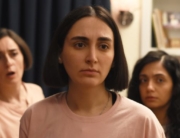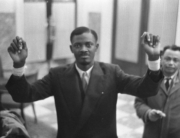Wunderkind Shane Carruth—he writes, directs, stars, produces, edits, photographs, and composes the music for his films—returns from a nine-year absence with his second feature, Upstream Color, which is beguiling and baffling, compelling and confounding in equal measure. In fact, the unsettling confusion a viewer may feel when watching this movie is a crucial part of its effect, one which mirrors the complex stew of emotions, identity confusion, romanticism, and whacked-out occurrences that the film’s characters navigate through. The result is a creation that is one of the most indelible, if sometimes frustratingly opaque, experiences in recent memory, one which is often mesmerizingly beautiful and at times profound, even as it skirts the edge of risible absurdity.
Back in 2004, Carruth won the Grand Jury Prize at Sundance for his debut feature, the twisty time travel thriller Primer, whose micro-budget belied its elegantly designed, head-scratching complexity. His long-awaited follow-up also traffics in a high-concept sci-fi premise, and the chilly formalism that distinguished Primer is in evidence here as well, but Carruth adds an emotional content and sensuality to the mix that injects an urgency that increases as the film progresses.
Summarizing this movie is as much a challenge as watching it, and may be beside the point, but here it goes anyway. The mysteries of Upstream Color begin immediately with the opening scenes. A man, identified in the credits as Thief (Thiago Martins), harvests grub worms in a makeshift lab with the assistance of two neighborhood boys, all of whom ingest the worms via a drink, which makes them exhibit strange behavior. The strangeness quickly takes on a sinister bent when Thief, seemingly at random, goes to a nightclub and kidnaps Kris (Amy Seimetz), a driven workaholic taking a rare break from career pressure. Thief forces her to ingest a grub worm. Thereafter, he takes up residence in her home, where he directs her to perform tasks through a kind of post-hypnotic suggestion—ingesting the worm has put Kris under Thief’s complete control. She drinks many glasses of water, folds paper into odd, origami-like patterns, and copies out and memorizes passages from Thoreau’s Walden. The Thief also drains her bank account by directing her to write out checks to him.
When Kris finally comes out of this trance, all her money is gone, and her body is covered with self-imposed knife wounds from trying to remove the worms crawling beneath her skin. She finds herself drawn to a pig farm, where a man called the Sampler (Andrew Sensenig) blasts strange, hypnotic music from giant speakers while tending to his animals. He offers to cure Kris by getting rid of the worms. This procedure involves transferring the worms from Kris to one of his pigs. She becomes a subject—or perhaps more accurately, a victim—of Sampler’s experiment, a process in which her consciousness becomes fused to that of a pig.
Shell-shocked and withdrawn, Kris has been stripped of everything she previously had. Besides her money, she loses her job due to being absent because of the kidnapping, and so she takes a job at a print shop, a much humbler (and presumably lower paid) profession than the one she was forced to leave. In her shaken state, while taking the train to work, she encounters Jeff (Shane Carruth), who, it turns out, has had similar experiences as Kris. As their relationship progresses, the circumstances that have bound them, as well as the outside forces (Thief and Sampler) that have altered their consciousness and sense of identity, become more menacing, and the dangers to their sanity, and perhaps their lives, become more apparent. In the final, nearly wordless section, Kris and Jeff strive to identify the source of what has happened to them and go to extreme lengths to resolve their unsettled anxieties.
The above narrative description admittedly misrepresents Upstream Color somewhat in that it makes it all seem much more straightforward than it really is, and it doesn’t begin to hint at its elusive, elliptical, deeply mysterious nature, or at what one experiences while watching it. Terrence Malick has rightly been cited by many critics as a major influence. The editing (by Carruth and David Lowery) especially recalls Malick in its free-floating, associative, and allusive approach to temporal and psychological space. Upstream Color jumps backwards and forwards in time within the same scene, and voiceover is frequently used as the glue that ties many of its images together. Carruth’s ethereal score beautifully captures the anxious, melancholic, and romantic nature of the proceedings. Another crucially important factor is the deeply committed and soulful performance by Amy Seimetz.
Upstream Color, while at times a bit too enamored with its own experimental approach to its narrative, impresses greatly with its visual beauty and thematic ambition. It’s an interactive experience in the best sense. By not revealing all its secrets easily, or in some cases not at all, this forces us to participate in interpreting, indeed creating, its meaning. By making us active agents instead of passive spectators, Carruth exhibits a bracing respect for, and faith in, the intelligence of his viewers.







Leave A Comment